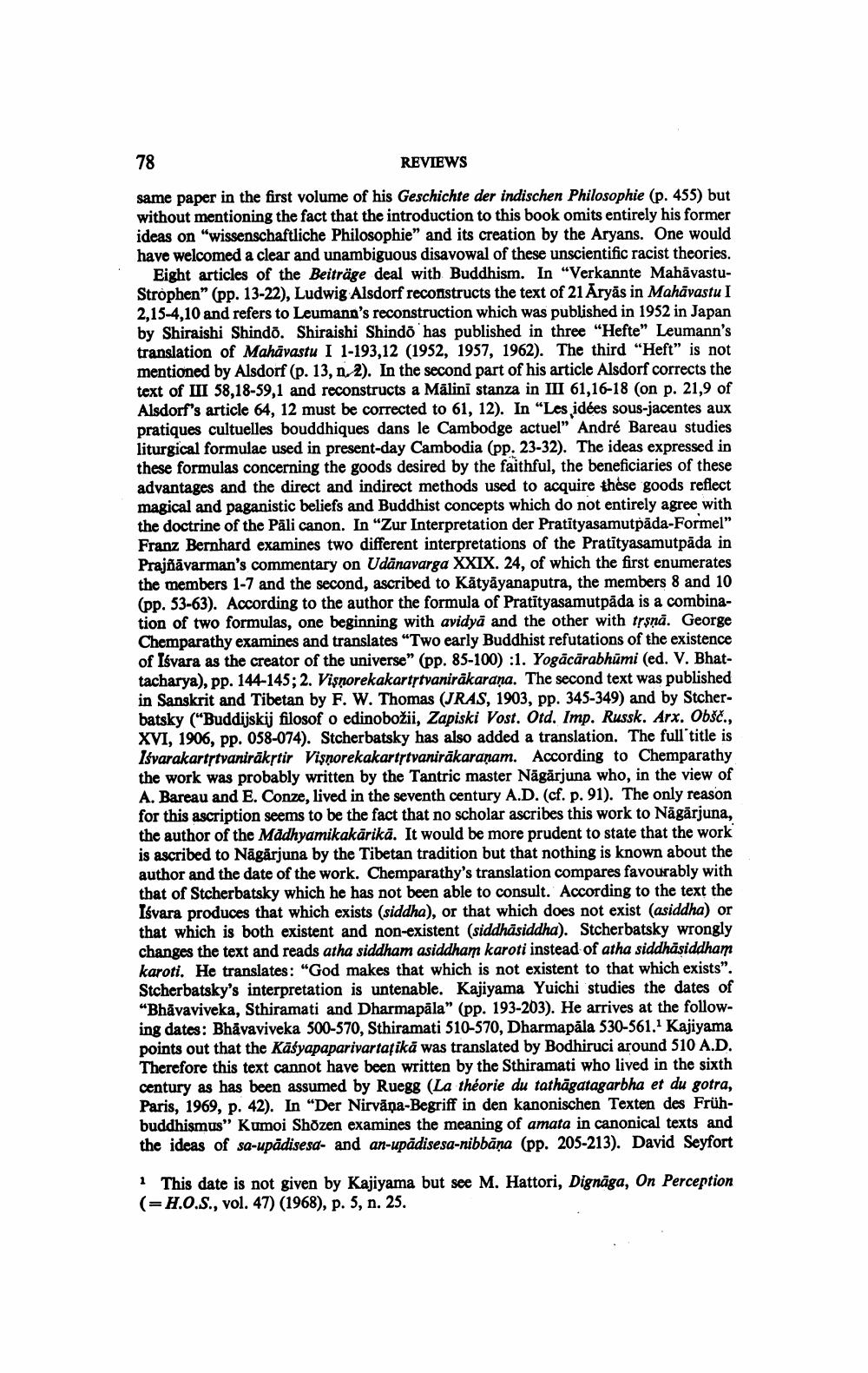Book Title: Reviews Of Different Books Author(s): Publisher: View full book textPage 2
________________ 78 REVIEWS same paper in the first volume of his Geschichte der indischen Philosophie (p. 455) but without mentioning the fact that the introduction to this book omits entirely his former ideas on "wissenschaftliche Philosophie" and its creation by the Aryans. One would have welcomed a clear and unambiguous disavowal of these unscientific racist theories. Eight articles of the Beitrage deal with Buddhism. In "Verkannte MahavastuStrophen" (pp. 13-22), Ludwig Alsdorf reconstructs the text of 21 Aryas in Mahavastu I 2,15-4,10 and refers to Leumann's reconstruction which was published in 1952 in Japan by Shiraishi Shindo. Shiraishi Shindo has published in three "Hefte" Leumann's translation of Mahavastu I 1-193,12 (1952, 1957, 1962). The third "Heft" is not mentioned by Alsdorf (p. 13, n. 2). In the second part of his article Alsdorf corrects the text of III 58,18-59,1 and reconstructs a Malini stanza in III 61,16-18 (on p. 21,9 of Alsdorf's article 64, 12 must be corrected to 61, 12). In "Les idees sous-jacentes aux pratiques cultuelles bouddhiques dans le Cambodge actuel" Andre Bareau studies liturgical formulae used in present-day Cambodia (pp. 23-32). The ideas expressed in these formulas concerning the goods desired by the faithful, the beneficiaries of these advantages and the direct and indirect methods used to acquire these goods reflect magical and paganistic beliefs and Buddhist concepts which do not entirely agree with the doctrine of the Pali canon. In "Zur Interpretation der Pratityasamutpada-Formel" Franz Bernhard examines two different interpretations of the Pratityasamutpada in Prajnavarman's commentary on Udanavarga XXIX. 24, of which the first enumerates the members 1-7 and the second, ascribed to Katyayanaputra, the members 8 and 10 (pp. 53-63). According to the author the formula of Pratityasamutpada is a combination of two formulas, one beginning with avidya and the other with trsna. George Chemparathy examines and translates "Two early Buddhist refutations of the existence of Isvara as the creator of the universe" (pp. 85-100) :1. Yogacarabhumi (ed. V. Bhattacharya), pp. 144-145; 2. Visnorekakartstvanirakarana. The second text was published in Sanskrit and Tibetan by F. W. Thomas (JRAS, 1903, pp. 345-349) and by Stcherbatsky ("Buddijskij filosof o edinobozii, Zapiski Vost. Otd. Imp. Russk. Arx. Obsc., XVI, 1906, pp. 058-074). Stcherbatsky has also added a translation. The full'title is Isvarakarttvanirakstir Visnorekakartytvanirakaranam. According to Chemparathy the work was probably written by the Tantric master Nagarjuna who, in the view of A. Bareau and E. Conze, lived in the seventh century A.D. (cf. p. 91). The only reason for this ascription seems to be the fact that no scholar ascribes this work to Nagarjuna, the author of the Madhyamikakarika. It would be more prudent to state that the work is ascribed to Nagarjuna by the Tibetan tradition but that nothing is known about the author and the date of the work. Chemparathy's translation compares favourably with that of Stcherbatsky which he has not been able to consult. According to the text the Isvara produces that which exists (siddha), or that which does not exist (asiddha) or that which is both existent and non-existent (siddhasiddha). Stcherbatsky wrongly changes the text and reads atha siddham asiddham karoti instead of atha siddhasiddham karoti. He translates: "God makes that which is not existent to that which exists". Stcherbatsky's interpretation is untenable. Kajiyama Yuichi studies the dates of "Bhavaviveka, Sthiramati and Dharmapala" (pp. 193-203). He arrives at the following dates: Bhavaviveka 500-570, Sthiramati 510-570, Dharmapala 530-561.1 Kajiyama points out that the Kasyapaparivartatika was translated by Bodhiruci around 510 A.D. Therefore this text cannot have been written by the Sthiramati who lived in the sixth century as has been assumed by Ruegg (La theorie du tathagatagarbha et du gotra, Paris, 1969, p. 42). In "Der Nirvana-Begriff in den kanonischen Texten des Fruhbuddhismus" Kumoi Shozen examines the meaning of amata in canonical texts and the ideas of sa-upadisesa- and an-upadisesa-nibbana (pp. 205-213). David Seyfort 1 This date is not given by Kajiyama but see M. Hattori, Dignaga, On Perception (=H.O.S., vol. 47) (1968), p. 5, n. 25.Page Navigation
1 2 3 4 5 6 7 8 9 10 11 12 13 14 15 16 17 18
